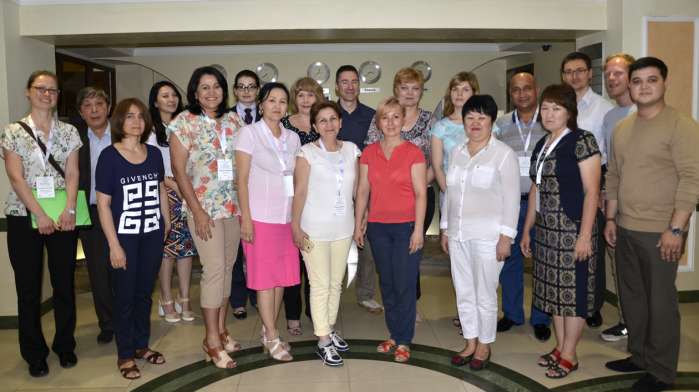Workshop discusses improvement of seasonal runoff forecasts
Within the 2nd work package of the CAWa project, the workshop “Statistical Models to Improve the Seasonal Runoff Forecast in Central Asian River Basins” was held in Almaty, 9-10 June 2016. Overall 24 participants, among them specialists from the forecasting departments of the national Hydrometeorological services of the five Central Asian countries and researchers from regional and German institutions discussed the state of seasonal runoff forecasting in Central Asia and the potential for improvement. CAWa researchers presented first preliminary results from statistical models which promise good forecasting results in data scarce Central Asian river basins.
Importance of seasonal runoff forecasting
With Central Asian economies heavily relying on river water availability during the vegetation season April-September, the seasonal runoff forecast are due by the start of the vegetation season in the beginning April. This is one of the major tasks of the national Hydrometeorological services. However, high spatio-temporal climate variability, coarse observational networks in the headwater catchments, and simplified methodological approaches frequently result in unsatisfactory runoff forecasts. The integrated water management for agricultural purposes, energy production and ecosystem functioning calls for longer-term forecasts with acceptable accuracy.
CAWa forecast approach
In its third project phase, the 2nd work package of the CAWa project intends to contribute to the improvement of seasonal runoff forecasts for Central Asian river basins by improving the forecasting skills, enhancing the lead times, and considering forecast uncertainties. The step-wise approach relies on freely available global as well as local climate and snow cover data sets and includes the following tasks:
- Remote-sensing based assessment of snow covered area using the MODSNOW Tool (Gafurov et al., 2016),
- Statistical forecast of river flow during the vegetation season based on multiple linear regression models with automatic predictor and model selection (Apel et al., 2016),
- Statistical forecast of winter precipitation anomalies based on global climate predictors (Gerlitz et. al., 2016,
- Uncertainty estimation based on automatically derived model ensembles.
Workshop program and outcomes
The workshop brought together specialists from the forecasting departments of the five Central Asian National hydrometeorological services to exchange on the currently used forecasting approaches and their reliability. Hydrologists and climatologists of GFZ German Research Centre for Geosciences presented their new approaches and promising preliminary results developed in the first year of the 3rd phase of the CAWa project.
The participating experts discussed the potential of the new models for improving the runoff forecast in terms of extending the lead-time and increasing the forecast accuracy. Finally, they agreed on a road map for the development of forecasting models for selected Central Asian river basins and the operational implementation of the new methods at the Hydrometeorological Services of Central Asian countries.
Further information about the forecast models developed in the frame of the CAWa project:
Apel, H., Gafurov, A., Gerlitz, L., Unger-Shayesteh, K., Vorogushyn, S., Merkushkin, A., Merz, B. (2016): Statistical prediction of seasonal discharge in the Naryn basin for water resources planning in Central Asia. Geophysical Research Abstracts, Vol. 18, EGU2016-8236. General Assembly European Geosciences Union (Vienna, Austria 2016).
Gafurov, A., Lüdtke, S., Unger-Shayesteh, K., Vorogushyn, S., Schöne, T., Schmidt, S., Kalashnikova, O., Merz (2016): MODSNOW-Tool (2016): an operational tool for daily snow cover monitoring using MODIS data. Environmental Earth Sciences 75: 1078, DOI: 10.1007/s12665-016-5869-x
Gerlitz, L., Vorogushyn, S., Apel, H., Gafurov, A., Unger-Shayesteh, K., and Merz, B. (2016): A statistically based seasonal precipitation forecast model with automatic predictor selection and its application to central and south Asia, Hydrol. Earth Syst. Sci., 20, 4605-4623, DOI:10.5194/hess-20-4605-2016.
Submitted by Katy Unger-Shayesteh on
